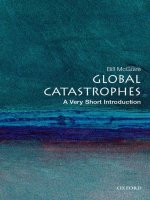Photography: a very short introduction
Bạn đang xem bản rút gọn của tài liệu. Xem và tải ngay bản đầy đủ của tài liệu tại đây (2.92 MB, 177 trang )
Photography: A Very Short Introduction
Very Short Introductions are for anyone wanting a stimulating
and accessible way in to a new subject. They are written by experts, and have
been published in more than 25 languages worldwide.
The series began in 1995, and now represents a wide variety of topics
in history, philosophy, religion, science, and the humanities. Over the next
few years it will grow to a library of around 200 volumes – a Very Short
Introduction to everything from ancient Egypt and Indian philosophy to
conceptual art and cosmology.
Very Short Introductions available now:
ANARCHISM Colin Ward
ANCIENT EGYPT Ian Shaw
ANCIENT PHILOSOPHY
Julia Annas
ANCIENT WARFARE
Harry Sidebottom
ANGLICANISM Mark Chapman
THE ANGLO-SAXON AGE
John Blair
ANIMAL RIGHTS David DeGrazia
ARCHAEOLOGY Paul Bahn
ARCHITECTURE
Andrew Ballantyne
ARISTOTLE Jonathan Barnes
ART HISTORY Dana Arnold
ART THEORY Cynthia Freeland
THE HISTORY OF
ASTRONOMY Michael Hoskin
Atheism Julian Baggini
Augustine Henry Chadwick
BARTHES Jonathan Culler
THE BIBLE John Riches
THE BRAIN Michael O’Shea
BRITISH POLITICS
Anthony Wright
Buddha Michael Carrithers
BUDDHISM Damien Keown
BUDDHIST ETHICS
Damien Keown
CAPITALISM James Fulcher
THE CELTS Barry Cunliffe
CHOICE THEORY
Michael Allingham
CHRISTIAN ART Beth Williamson
CHRISTIANITY Linda Woodhead
CLASSICS Mary Beard and
John Henderson
CLAUSEWITZ Michael Howard
THE COLD WAR Robert McMahon
CONSCIOUSNESS Susan Blackmore
CONTEMPORARY ART
Julian Stallabrass
Continental Philosophy
Simon Critchley
COSMOLOGY Peter Coles
THE CRUSADES
Christopher Tyerman
CRYPTOGRAPHY
Fred Piper and Sean Murphy
DADA AND SURREALISM
David Hopkins
Darwin Jonathan Howard
THE DEAD SEA SCROLLS
Timothy Lim
Democracy Bernard Crick
DESCARTES Tom Sorell
DESIGN John Heskett
DINOSAURS David Norman
DREAMING J. Allan Hobson
DRUGS Leslie Iversen
THE EARTH Martin Redfern
EGYPTIAN MYTH Geraldine Pinch
EIGHTEENTH-CENTURY
BRITAIN Paul Langford
THE ELEMENTS Philip Ball
EMOTION Dylan Evans
EMPIRE Stephen Howe
ENGELS Terrell Carver
Ethics Simon Blackburn
The European Union
John Pinder
EVOLUTION
Brian and Deborah Charlesworth
FASCISM Kevin Passmore
FEMINISM Margaret Walters
FOSSILS Keith Thomson
FOUCAULT Gary Gutting
THE FRENCH REVOLUTION
William Doyle
FREE WILL Thomas Pink
Freud Anthony Storr
Galileo Stillman Drake
Gandhi Bhikhu Parekh
GLOBAL CATASTROPHES
Bill McGuire
GLOBALIZATION
Manfred Steger
GLOBAL WARMING
Mark Maslin
HABERMAS
James Gordon Finlayson
HEGEL Peter Singer
HEIDEGGER Michael Inwood
HIEROGLYPHS Penelope Wilson
HINDUISM Kim Knott
HISTORY John H. Arnold
HOBBES Richard Tuck
HUMAN EVOLUTION
Bernard Wood
HUME A. J. Ayer
IDEOLOGY Michael Freeden
Indian Philosophy
Sue Hamilton
Intelligence Ian J. Deary
ISLAM Malise Ruthven
JOURNALISM Ian Hargreaves
JUDAISM Norman Solomon
Jung Anthony Stevens
KAFKA Ritchie Robertson
KANT Roger Scruton
KIERKEGAARD Patrick Gardiner
THE KORAN Michael Cook
LINGUISTICS Peter Matthews
LITERARY THEORY
Jonathan Culler
LOCKE John Dunn
LOGIC Graham Priest
MACHIAVELLI Quentin Skinner
THE MARQUIS DE SADE
John Phillips
MARX Peter Singer
MATHEMATICS Timothy Gowers
MEDICAL ETHICS Tony Hope
MEDIEVAL BRITAIN
John Gillingham and
Ralph A. Griffiths
MODERN ART David Cottington
MODERN IRELAND Senia Pasˇe t a
MOLECULES Philip Ball
MUSIC Nicholas Cook
Myth Robert A. Segal
NATIONALISM Steven Grosby
NIETZSCHE Michael Tanner
NINETEENTH-CENTURY
BRITAIN Christopher Harvie and
H. C. G. Matthew
NORTHERN IRELAND
Marc Mulholland
PARTICLE PHYSICS Frank Close
paul E. P. Sanders
Philosophy Edward Craig
PHILOSOPHY OF LAW
Raymond Wacks
PHILOSOPHY OF SCIENCE
Samir Okasha
PHOTOGRAPHY Steve Edwards
PLATO Julia Annas
POLITICS Kenneth Minogue
POLITICAL PHILOSOPHY
David Miller
POSTCOLONIALISM
Robert Young
POSTMODERNISM
Christopher Butler
POSTSTRUCTURALISM
Catherine Belsey
PREHISTORY Chris Gosden
PRESOCRATIC PHILOSOPHY
Catherine Osborne
Psychology Gillian Butler and
Freda McManus
QUANTUM THEORY
John Polkinghorne
THE RENAISSANCE Jerry Brotton
RENAISSANCE ART
Geraldine A. Johnson
ROMAN BRITAIN Peter Salway
THE ROMAN EMPIRE
Christopher Kelly
ROUSSEAU Robert Wokler
RUSSELL A. C. Grayling
RUSSIAN LITERATURE
Catriona Kelly
THE RUSSIAN REVOLUTION
S. A. Smith
SCHIZOPHRENIA
Chris Frith and Eve Johnstone
SCHOPENHAUER
Christopher Janaway
SHAKESPEARE Germaine Greer
SIKHISM Eleanor Nesbitt
SOCIAL AND CULTURAL
ANTHROPOLOGY
John Monaghan and Peter Just
SOCIALISM Michael Newman
SOCIOLOGY Steve Bruce
Socrates C. C. W. Taylor
THE SPANISH CIVIL WAR
Helen Graham
SPINOZA Roger Scruton
STUART BRITAIN John Morrill
TERRORISM
Charles Townshend
THEOLOGY David F. Ford
THE HISTORY OF TIME
Leofranc Holford-Strevens
TRAGEDY Adrian Poole
THE TUDORS John Guy
TWENTIETH-CENTURY
BRITAIN Kenneth O. Morgan
THE VIKINGS Julian D. Richards
Wittgenstein A. C. Grayling
WORLD MUSIC Philip Bohlman
THE WORLD TRADE
ORGANIZATION
Amrita Narlikar
Available soon:
AFRICAN HISTORY
John Parker and Richard Rathbone
CHAOS Leonard Smith
CITIZENSHIP Richard Bellamy
economics
Partha Dasgupta
EXISTENTIALISM
Thomas Flynn
THE FIRST WORLD WAR
Michael Howard
FUNDAMENTALISM
Malise Ruthven
HIV/AIDS Alan Whiteside
HUMAN MIGRATION
Khalid Koser
INTERNATIONAL RELATIONS
Paul Wilkinson
NEWTON Robert Iliffe
PSYCHIATRY Tom Burns
RACISM Ali Rattansi
For more information visit our web site
www.oup.co.uk/general/vsi/
Steve Edwards
PHOTOGRAPHY
A Very Short Introduction
1
3
Great Clarendon Street, Oxford ox2 6dp
Oxford University Press is a department of the University of Oxford.
It furthers the University’s objective of excellence in research, scholarship,
and education by publishing worldwide in
Oxford New York
Auckland Cape Town Dar es Salaam Hong Kong Karachi
Kuala Lumpur Madrid Melbourne Mexico City Nairobi
New Delhi Shanghai Taipei Toronto
With offices in
Argentina Austria Brazil Chile Czech Republic France Greece
Guatemala Hungary Italy Japan Poland Portugal Singapore
South Korea Switzerland Thailand Turkey Ukraine Vietnam
Oxford is a registered trade mark of Oxford University Press
in the UK and in certain other countries
Published in the United States
by Oxford University Press Inc., New York
© Steve Edwards 2006
The moral rights of the author have been asserted
Database right Oxford University Press (maker)
First published as a Very Short Introduction 2006
All rights reserved. No part of this publication may be reproduced,
stored in a retrieval system, or transmitted, in any form or by any means,
without the prior permission in writing of Oxford University Press,
or as expressly permitted by law, or under terms agreed with the appropriate
reprographics rights organizations. Enquiries concerning reproduction
outside the scope of the above should be sent to the Rights Department,
Oxford University Press, at the address above
You must not circulate this book in any other binding or cover
and you must impose this same condition on any acquirer
British Library Cataloguing in Publication Data
Data available
Library of Congress Cataloging in Publication Data
Data available
Typeset by RefineCatch Ltd, Bungay, Suffolk
Printed in Great Britain by
Ashford Colour Press Ltd., Gosport, Hants
ISBN 0–19–280164–3 978–0–19–280164–7
13579108642
For JX B, JW (and G)
This page intentionally left blank
Contents
Preface xi
List of illustrations xiv
1 Forgetting photography 1
2 Documents 12
3 Pictures 40
4 What is a photograph? 67
5 The apparatus and its image 85
6 Fantasy and remembrance 112
Afterword: Digital photography 129
Further reading 141
Index 155
This page intentionally left blank
Preface
I must have been mad to agree to write this book; not least,
because the combination ‘very short introduction’ with
‘photography’ seems like an oxymoron. The three or four standard
histories of the medium are all huge volumes. The problem is
simply that photography runs in all directions, permeating diverse
aspects of society. Indeed, it is difficult to find an area of modern
life untouched by it. (Even the cover of this book, ostensibly an
abstract painting, is photomechanically reproduced.) The critic
John Tagg once suggested that there was no single characteristic,
or practice, that represented the fundamental essence of the
medium. Trying to account for photography as a whole, he
suggested, was akin to attempting a history, or a museum, of
writing: all that could be done was to trace the uses of photography
(or writing) in the institutions in which it was put to work – the
law courts, medicine, advertising, art, and so forth. Even if we
reject a strict version of this argument (it seems to me that there
are powerful ideologies underpinning the uses of photography),
attempting to write an introduction to this dispersed field feels like
a vain task. The quite distinct versions of photography’s history
unravel attempts to tell a coherent story. This is one of the things
that can make thinking about photography so fascinating, and so
challenging.
In this short book I have not even tried to provide anything like a
xi
comprehensive account: some of the most important aspects of
the field – advertising, for instance – barely figure here. Instead, I
have tried to address some constitutive conditions that give rise to
the values we typically associate with photographs. This approach
means emphasizing the division between art and documentary. I
have also adopted a thematic, rather than chronological,
organization for this book; information on the development of
photography, for instance, is scattered throughout the pages. My
aim has been to embed specific information in a wider frame – I
hope this approach results in a livelier introduction to the subject,
but the reader may need to actively look for connections. Chapter 1
takes the theme of forgetting as a way of introducing photography.
Chapters 2 and 3 form a complementary pair, providing a survey of
issues and themes associated with the division between ‘documents’
and ‘pictures’. Chapters 4 and 5 go over some of the same ground,
but with a more theoretical emphasis. The final chapter returns to
the uses of photography, advancing some thoughts on commodity
culture and memory. I felt that I could not leave the book without a
short coda on the ‘digital image’ and its impact on established
photographic culture.
Outside the museum, we rarely encounter photographs in a pure, or
self-contained, form. Invariably, in actual use photographic images
are combined with language and some other technology.
Photographs often appear on the page (of a book, magazine, or
newspaper), combined with text; they figure on billboards (again
with words); in archives and filing cabinets; on personal
identification documents; in family albums (or, their modern
replacement, the reassigned shoe box); on computer systems; and
so forth. Photography is a hybrid medium, and it is worth
remembering that the way we encounter and use photographic
images frequently involves some other system of communication
and organization. I touch on this combinatory relation in what
follows, but in the main, this book focuses on camera-generated
photochemical images, though I have occasionally drawn my
examples from the related family of technologies that share the
xii
determining conditions of the camera (film, television, video, and
digital photography). One final point: anyone hoping to find a ‘how
to’ manual here will be disappointed.
xiii
List of illustrations
1 Sunday People,
29 July 2001 8
Mirror Syndication International/
John Frost Newspapers
2 Medical image inside
the body 10
© David M. Martin
MD/Science Photo Library
3 Marcelin, ‘Portraits of
Yesterday and Today’,
from Journal Amusant,
6 September 1856 13
4 Eugène Atget, Balcon,
17 rue du Petit Point,
1912–13 17
Museum of Modern Art,
New York/© Scala, Florence
5 Honoré Daumier,
‘Croques Dramatiques’,
from Le Charivari,
1853 20
www.daumier.org
6 John Lamprey, ‘Front
and Profile Views of
a Malayan Man’,
c. 1868–9 25
Royal Anthropological Society
of Great Britain and Ireland
7 Roger Fenton, The
Valley of the Shadow
of Death, 1855 29
Courtesy of the Library of
Congress
8 Robert Capa, Death of
a Loyalist Soldier,
Spain, 1936 30
Magnum Photos
9 Susan Meiselas, Street
Fighter in Managua,
1981 38
Magnum Photos
xiv
10 Gertrude Käsebier,
The Road to Rome,
1903 46
Princeton University Art
Museum. Gift of the Estate of
Mina Turner. Photo: Bruce M.
White
11 Germaine Krull, ‘Dans
toute sa force’, from
VU, 1928 52
© Estate of Germaine Krull.
Museum Folkwang, Essen
12 Henri Cartier-Bresson,
Behind the Gare St
Lazare, 1932 54
Magnum Photos
13 Lee Friedlander,
Hillcrest, New York,
1970 57
Fraenkel Gallery, New York
14 Cindy Sherman,
Untitled Film Still
No. 37, 1979 65
Courtesy of the artist
and Metro Pictures Gallery
15 Portable camera
obscura for drawing
from nature, 1781 74
Private collection
16 Daguerre, Still Life,
1837 77
Société française de
photographie, Paris
17 William H. Rau,
New Railroad,
Duncannon,
Pennsylvania,
c. 1890–1900 92
The J. Paul Getty Museum,
Los Angeles
18 Antonello da Messina,
St Jerome in His
Chamber, c. 1475 95
© National Gallery
Collection; by kind permission
of the Trustees of the
National Gallery, London/Corbis
19 Peter Henry Emerson,
A Stiff Pull, 1888 98
The Bodleian Library, University
of Oxford (247126 b.1 Plt.4)
20 Alfred Stieglitz,
Equivalent, 1930 106
Photograph, gelatin silver print.
Image (sight): 9.1 × 11.8 cm
(3 9/16 × 4 5/8 in.); (framed) 37.1
× 29.5 cm (14 5/8 × 11 5/8 in.)
Museum of Fine Arts, Boston.
Gift of Miss Georgia O’Keeffe.
Photo: © 2006 MFA Boston
21 Robert Doisneau,
Helicopters, Tuileries
Gardens, 1972 108
Ackland Art Museum,
University of North
Carolina at Chapel Hill.
Gift of William A. Hall, III
(81.63.1.12)
22 Image of a woman on
a beach 114
© H. G. Rossi/Zefa/Corbis
xv
23 Abu Ghraib prison,
Iraq 116
© Mark St George/Rex Features
24 Jo Spence 123
Terry Dennett/Jo Spence
Memorial Archive
The publisher and the author apologize for any errors or omissions
in the above list. If contacted they will be pleased to rectify these at
the earliest opportunity.
xvi
Chapter 1
Forgetting photography
The question ‘Where is the photograph?’ presupposes that we have
lost sight of photography or that photography is somehow lost; that
it has lost a direction perhaps or that we do not find it where it
should be; that it has been misplaced; that it remains somewhere,
unclaimed, in some lost property office of culture.
Olivier Richon
In 1865, the photographer James Mudd presented a paper entitled
‘A Photographer’s Dream’ at the Manchester Literary and
Philosophical Society (Photographic Section). Mudd tells the story
of a photographer who falls asleep and wakes in the 29th century.
This fable represents a parody of, what Mudd saw as, the dire state
of photography in the mid-19th century. His goal was to see
photography valued as one of the fine arts (his particular passion
was for picturesque landscapes), but photographers obsessed with
chemical processes and optical devices undermined this ambition.
In his ‘dream’ he was conducted through a swanky new Manchester
to the ‘Grand Focus Photographic Society’. But, whereas he had
expected to find photography transformed into art, he encountered
just more of the same. The participants in the Society came up with
one mad scheme after another: a camera, called a pointer, wound
up and sent in search of views; steam proposed to raise
photography to new heights; and so on. Mudd was aghast to find
that photography had not really changed in all this time; still no one
1
seemed interested in art. In fact, it turned out that there had been
little opportunity for progress; he learned that, in the intervening
years, photography had been lost and had only recently been
‘discovered’. This simple tale proposes a period of more than 1,000
years of modern history without photographs. It is a remarkably
interesting idea.
William Bornefeld’s science-fiction novel Time and Light is set in a
post-apocalyptic society called Fullerton, where photographs are
forbidden. In place of the seductions of images, the inhabitants of
Fullerton have the ‘pill’ (half anti-depressant, half sexual stimulant).
But, during a scientific expedition to the (allegedly) irradiated
world beyond the domed city, the central character, Dr Noreen,
discovers 12 ancient photographs from the 20th century. Even
during his medical training Dr Noreen’s contact with pictures had
been restricted to a few diagrams. But when he encounters an
ancient archival facility and takes a packet of images (oddly enough,
all by well-known photographers; including one by the author) he
becomes obsessed with these illicit pictures and flouts the
iconophobic rule that predominates among the last surviving
humans – which Bornefeld calls, in a bad photographic joke,
‘The Family of Man’ – spending hours absorbed in contemplating
an image of peppers by Edward Weston, or Robert Capa’s picture of
a Spanish Republican soldier depicted at the moment of his death.
Noreen is rash enough to show his images to two other citizens:
gradually his promising career and social progress disintegrate
around him. Ultimately, Noreen’s search for more photographs
leads him to challenge the norms and protocols that govern
Fullerton: the ruling bureaucrats respond with the ultimate
iconophobic gesture and surgically destroy his vision.
It is difficult for us to imagine these imageless future times. The
rapid spread of phone technology for making photographs has only
exacerbated this situation: we all now live our lives in the presence
of pictures. Dr Noreen’s world, in which photographs are
prohibited, seems particularly odd because they do so much work in
2
Photography
our society that it is hard to imagine the ruling powers voluntarily
renouncing them. However, it seems helpful to begin this short
introduction with Mudd and Bornefeld, and to contemplate a world
without photographs. So let’s leap forward into the imageless
future.
In Mudd’s future, if not Bornefeld’s, drawings could substitute for
camera-generated images, but drawing is a slow, and highly skilled,
process. One key impetus behind the invention of photography in
the 1830s was the desire to escape from the restrictions imposed by
handcrafted images. What is more, in the absence of photographic
reproduction techniques, if drawings are to be issued in significant
numbers they will need to be hand engraved onto a metal plate or
wooden block. Two key consequences result from this laborious
technique: both would significantly limit the number of images in
circulation.
Firstly, hand-drawn images are expensive to produce, because they
require skill and time. When picture production involves the
expenditure of effort, time, and money, images are likely to be
restricted to the illustration of significant things. Photography, in
contrast, excels at depicting everyday life and casual appearances.
Consequently, throughout its history, the hand-made image has
been, invariably, reserved for prestigious projects: images of the
powerful and the famous, world historical events, subjects deemed
elevating or worthy of attention by official culture. Imagine, for
instance, the magazines currently on display in any newsagent
deprived of their photographs. Many of these publications depend
for their appeal on their pictures, and a good percentage would,
undoubtedly, cease to exist without them. Would gardening, DIY, or
fashion magazines, or those weird lads’ mags, have half the appeal
without their images? Would anyone go to the time and expense of
reproducing this stuff in the absence of cameras? The people in
Mudd’s future would find very few illustrated books, magazines,
and newspapers available to them; even for those who could afford
them, images of their family and friends would be limited to a few
3
Forgetting photography
formal portraits. Secondly, whereas photography is more-or-less
instantaneous, even the most rapid sketch requires time to execute.
Moving subjects can only be reproduced as an artist’s impression.
(It took photography to establish the way a running horse plants its
feet.)
In a number of pioneering texts written during the 1920s and
1930s, the German critic Walter Benjamin argued that photography
should be thought of as a technology of the ‘optical unconscious’.
Benjamin’s analogy was with psychoanalysis, which allegedly
brought the murky realms of the unconscious into view: he believed
photography did something similar for the aspects of our world that
eluded standard vision. He had in mind the ability of the camera to
extend human observation beyond its normal parameters. All
manner of instruments are regularly employed to enhance vision:
eye-glasses, magnifying glasses, simple microscopes, and telescopes
to name just a few. Some of these instruments are straightforward
to use and we are readily familiar with their results. These optical
devices are, though, designed to be used individually and
communicating their findings can be difficult. What an observer
sees in a simple microscope or telescope can be recorded in a
drawing, but doing so requires a great deal of skill and patience: the
objects of study often move or metamorphose, and the focus of
attention has to be repeatedly shifted from the eyepiece to the
paper. (There are plenty of examples in which what the observer
recorded did not exist.)
The camera is particularly suited for combination with optical
devices because the instrument can be substituted for the regular
lens and rapid modern shutters and films allow for an almost
instantaneous arrest of motion. In this way, images otherwise
invisible to the eye can be revealed. Some complex instruments –
scanning microscopes, ultrasound scanners, and so forth – require a
photographic image (or video/computer screen) to manifest their
results: there is nothing to see in the absence of photographic film
or screen. Images from inaccessible places are also made available
4
Photography
by photographers (not many of us are likely to explore the depths of
the ocean). Satellite photographs of the Earth and its weather
systems, or images of distant planets, are only possible from a point
of view that is literally ‘out of this world’. The ability to make
pictures at a fraction of a second (or in film to slow down motion
and freeze frame) brings things that we could otherwise never
observe into focus: we are able to discern whether the ball crossed
the line or to capture a humming bird in flight. Infrared
photography allows us to see in the dark, while telescopic
photography enables observers to record dangerous events at a safe
distance (or to spy and pry). If we add the microcameras that enable
medics to see inside the body without the need for invasive surgery
to this list, the stakes are raised once more. Much of our world
would be invisible to those in the imageless future cities of
Manchester and Fullerton.
It is difficult to grasp just how much would be lost to us under
these circumstances. Most of all, I suspect, the inhabitants of
the future would miss out on pictures of simple appearances:
the look of a volcano erupting, or a close-up of a dragonfly’s
wings; the pattern made by a drop of water, or the record of a
daft outfit worn at a party. The world would seem much less
knowable in the absence of these images: our familiarity with
tropical islands and deserts, anacondas and aardvarks, stems, in
the main, from lens-based imagery. (Perhaps zoological and
botanical gardens would undergo a spectacular revival in the
photo-less millennia.)
Much of our familiarity with our world comes through
photographic visualization as a surrogate for first-hand experience
of places, objects, creatures, and events. Photographs have made
many things seem ordinary, bringing distant places or unusual
things closer to us, but, at the same time, our reliance on them has
been at the cost of making much of our experience seem second-
hand. It is startling to think how much of our knowledge comes
through the medium of photography: how many of us have actually
5
Forgetting photography
seen a polar ice flow or a refugee camp? Yet we are able to describe
the appearance of both. In this sense, we relate to our world through
the ‘second nature’ of technology. Photography occupies a central
role in that process. An iconophobic future might make some
important gains by dispensing with the mediation of cameras, but
the costs would be immense. Images associated with the optical
unconscious have played a fundamental role in demystifying our
world; without them enchantment would have a greater grip on our
understanding.
As we have already observed, in Mudd’s future dependence on
drawings would mean the everyday images of friends and relatives,
pets and prized possessions, would be likely to disappear: there
would be no envelopes stuffed with pictures from high days and
holidays. These things are completely absent from Noreen’s
Fullerton. In these imageless societies, it is likely that many people
would leave no visual trace of their lives. This was the condition for
most of the world’s inhabitants before photography (early
photographers often dreamed of a photograph of Shakespeare), and
after its loss, or eradication, most people would return to what the
critic Siegfried Kracaeur called, in another context, ‘imageless
oblivion’. However, this situation would, once again, allow the
prestige of pictures to devolve to the rich and powerful. (For the
poor and the powerless, the ability to avoid the official gaze has
some definite advantages.)
The modern state employs photographs (and other related
lens-based media) in myriad ways, and, at least, in Bornefeld’s
full version of ‘imageless oblivion’ its operations would be
considerably hampered by their absence. In addition to political
‘spin’ and promotion, images of this kind are used for
disseminating public information; traffic control; recording
forensic evidence and presenting that evidence in court;
surveillance in banks, city streets, or on demonstrations; for
staking out a criminal suspect and recording his or her contacts.
Perhaps, most of all, photographs are employed to produce
6
Photography
records of individuals. All manner of official documents demand
portraits of their holders, including passports, driving licences,
library cards, and so forth. In many parts of the world people are
obliged to carry identity cards (British citizens may soon be
required to join them). Imagine how much easier it would be to take
on a different identity before – or after – photography. Charles
Dickens gave a great description of the trouble it took to identify
individuals in a period before their likenesses could be
photographically produced. For example, jailers were required to
scrutinize each prisoner and memorize his or her appearance. The
police began using photography seriously in the 1870s. With the
emergence of fingerprinting, and subsequently DNA testing,
photography occupies a less central place in identification. But,
while these other technologies allow identity to be confirmed,
photographs make it much easier to spot an individual. In Noreen’s
future, the police can keep tabs on everyone because there are so
few remaining people; in contrast, Mudd’s millennia without
photographs must offer lots of possibilities for becoming invisible,
for moving city and starting over.
There are some phenomena in our society that are, to a large
extent, the products of photography and could not survive in these
future worlds, or at least could not do so in their present form.
Two examples will have to make the point. Celebrity is one of
those phenomena that could hardly exist without the camera.
Fame predates photography, but celebrity developed with the
image technology of industrial capitalism. In the 1860s British
dealers regularly ordered 10,000 photographs of prominent
celebrities. The revival of the popularity of the British royal family
dates from roughly the moment around the middle of the
19th century when they began to promote themselves as homely
bourgeois citizens. Photography played an important role in this
process. The first photograph of a member of the British royal
family to be shown in public appeared in 1857; within a few days of
its issue, in 1860, 60,000 sets of Mayall’s photographic Royal
Album had been ordered. From the point at which image and text
7
Forgetting photography
could be produced in mass editions (the late 19th century), a
symbiosis took place between popular journalism and celebrity: the
publicity-hungry could then keep themselves in the public eye,
while the media traded on this visibility. The modern tabloid press
feeds on celebrity pictures, even if these days they show
considerably less reverence for their subjects. Increasingly,
paparazzi work has become more prying and voyeuristic, but this
1. The Sunday People, 29 July 2001
8
Photography









